We live in a world of injustice, where millions of people in the Western world are overweight and suffering from related health problems while millions more are starving. Farming of livestock is criticised by animal welfare groups for its cruel methods and by environmental campaigners concerned about the industry's significant contribution to Greenhouse Gas emissions. As the population increases rapidly, and housing, energy and food industries continue to compete for space, the situation can only get worse. Meat consumption of the world is predicted to double by 2050. A world in which all these problems are solved sounds like a utopia. Even more so, for many people, if meat could remain on the menu.
The world's most expensive beefburger, grown in a laboratory from stem cells, has the potential to be the change the world is waiting for.
Currently, 30% of Earth's usable surface is covered by pasture land for animals, compared with 4% used directly to feed humans. This is a huge portion of the Earth's surface dedicated to producing meat, which could be put to better use if we had a more efficient alternative. Livestock farming accounts for 5% of CO2 emissions and 40% of methane emissions, which is a more harmful greenhouse gas. Laboratory-grown meat could provide a sustainable way to meat the ever-increasing demand for meat, while potentially eradicating animal cruelty through farming. The meat would be an animal flesh product that has never been part of a living animal. However, there are many problems to overcome before such a product could become commercial, not least convincing the public that it is safe and ethical. Many people are put off the idea of eating artificial meat because they believe we shouldn't eat meat that hasn't developed naturally. Yet easily accessible and detailed information about the product should help consumers see the benefits of artificial meat and reduce any fears they may have.
PETA's challenge
It was People for the Ethical Treatment of Animals (PETA) who tried to gain momentum behind the idea of artificial meat in 2008, when they promised a prize of $1 million for any scientist that could grow an in vitro (in a test tube, Latin: in glass) chicken. At the time, PETA were referencing President Hoover's promise of a 'chicken in every pot', without realising that producing artificial versions of other meats would have a more significant ethical impact. Though no one has yet created an in vitro chicken, as of 2012, 30 laboratories from around the world had announced they're working on research to produce some form of in vitro meat. Considering their challenge a success, but acknowledging the science is not quite close enough to their goal, PETA abandoned the prize on March 4th 2014.
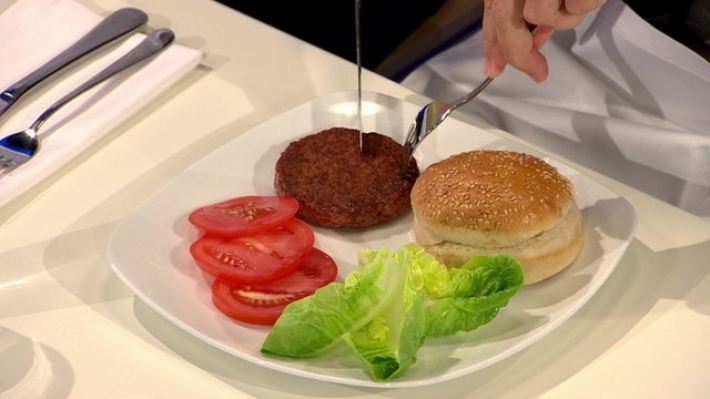
The world's first in vitro beef burger, eaten on live television, created by a research team at Maastricht University.
Credit: BBC
The world's most expensive hamburger
In August of last year, a news conference in London hosted the world's first tasting of a lab grown burger. It was created by a research team from Maastricht University in the Netherlands. Food critics were invited to give their professional opinion, and on the whole, they praised the burger's texture and likeness to real meat. However, they noted the absence of fat, the cells of which are difficult to replicate, and this had an impact on the flavour. What what exactly is this 'artificial meat' made from? And what processes does it undergo before it reaches the burger bun?
The meat originates from stem cells. These are cell templates with no specific purpose, which have the potential to differentiate and produce specialised tissues, such as skin or nerve cells. Stem cells are taken from cows, then allowed to divide in flasks. They divide in a gel-like growth medium containing antibiotics, nutrients and growth-promoting chemicals. After about three weeks, these quickly-dividing stem cells will have produced more than a million copies. Samples of these cells are then put into smaller dishes where they form small muscle tissues, called 'myotubes', which are tiny hoops of white protein. These tissue samples are collected into pellets and frozen, later to be defrosted and compacted into a burger shape before being cooked. This is quite a meticulous and time-consuming process, not to mention expensive, though it does take less time than keeping a cow until it is time to be slaughtered.
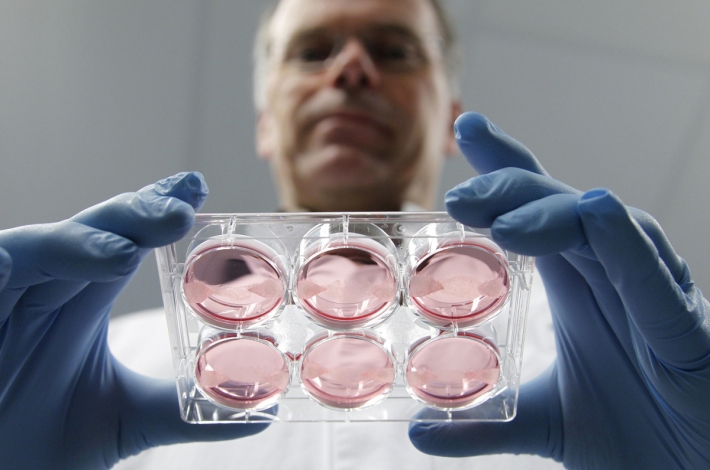
Professor Mark Post with petri dishes of stem cells.
Credit: Francois Lenoir / Reuters
The project had a mysterious financier, who was revealed only recently as Sergey Brin, co-founder of Google, who donated £215,000 ($330,000) towards the research. He acknowledged that some people would probably think synthetic meat was science fiction and that it was likely to be met with some cynicism:
"I actually think that's a good thing. If what you're doing is not seen by some people as science fiction, it's probably not transformative enough."
-- Sergey Brin
The contribution was extremely important, considering the cost of producing just one of these burgers is in the region of £200,000. The cost will have to be reduced significantly before it becomes commercially viable. At the moment, it is only possible to produce small scraps of meat to form products like burgers and sausages that are otherwise made out of scraps and leftover cuts. In order to produce larger portions of meat, like a steak, for example, an artificial circulatory system would be required. This would deliver nutrients and oxygen throughout the meat along blood vessels, and to remove waste products. However, developing a working circulatory system would be quite a challenge, as it requires the growth of other cell types and chemical messengers to direct the growing tissue.
One other concern is the appearance of the meat, as the artificial product is white in colour. Research is planned to try adding naturally-occurring myoglobin to make the lab grown tissue look red in colour. For the purposes of the conference, the burger meat was coloured red with beetroot juice. It also contained breadcrumbs, caramel and saffron to hold the meat together and to make the texture and appearance more authentic.
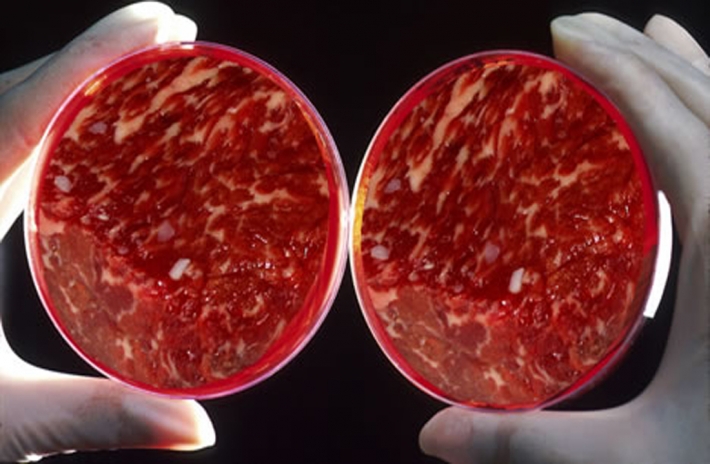
I'm inclined to believe that this image is an artist's very liberal rendition, partly because the meat in the dishes is remarkably red in colour and also because it appears to be streaked with sections of fat cells.
Credit: four-magazine
These modifications are all to disguise the fact that the burger is not made from real beef. It seems that manufacturers of these artificial meats are very concerned about making them taste and appear to be as 'natural' as possible. There are many people who, even if they understand the process undertaken to produce the meat and have accepted that the meat is safe and has ethical benefits, would still feel very uncomfortable about eating meat grown in a laboratory.
Atwood's 'ChickieNobs'
Such artificial meat is reminiscent of the 'ChickieNobs' of Margaret Atwood's dystopian series of novels that begins with 'Oryx and Crake'. In her fictional universe, shortages in supplies of meat and experimentation with biotechnology have resulted in the mass production of artificial chicken, marketed as 'ChickieNobs'.
Jimmy's horror upon being shown the production of 'ChickieNobs' is likely to echo the response of large numbers of people to the thought of eating artificial meat.
"This is the latest," said Crake.
What they were looking at was a large bulblike object that seemed to be covered with stippled whitish-yellow skin. Out of it came twenty thick fleshy tubes, and at the end of each tube another bulb was growing.
"What the hell is it?" said Jimmy.
"Those are chickens," said Crake. "Chicken parts. Just the breasts, on this one. They've got ones that specialize in drumsticks too, twelve to a growth unit."
"But there aren't any heads," said Jimmy. He grasped the concept-- he'd grown up with sus multiorganifer, after all-- but this thing was going too far. At least the pigoons of his childhood hadn't lacked heads.
"That's the head in the middle," said the woman. "There's a mouth opening at the top, they dump nutrients in there. No eyes or beak or anything, they don't need those."
"This is horrible," said Jimmy. The thing was a nightmare. It was like an animal-protein tuber.
"Picture a sea-anemone body plan," said Crake. "That helps."
"But what's it thinking?" said Jimmy.
The woman gave her jocular woodpecker yodel, and explained that they'd removed all the brain functions that had nothing to do with digestion, assimilation, and growth.
"It's sort of like a chicken hookworm," said Crake.
-- Atwood, 'Oryx and Crake', Chapter 8, Wolvogs.
(For the curious, a 'pigoon', or 'sus multiorganifer' is an animal grown with a mix of pig and human DNA with the sole purpose of providing organs for transplant into humans.)
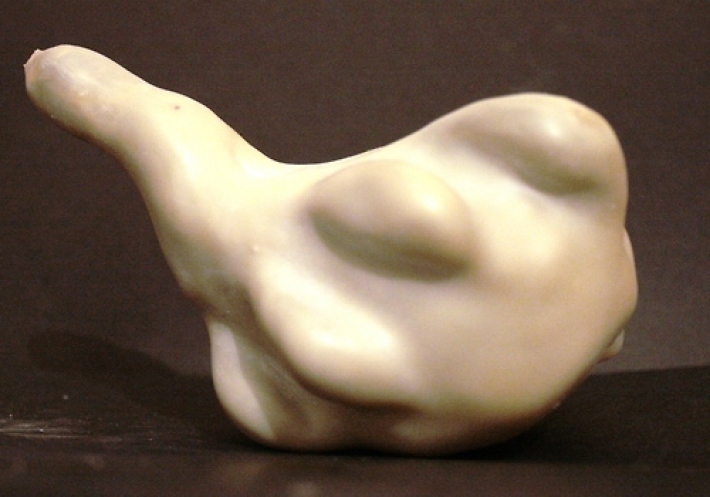
'ChickieNobs'.
Credit: Karley Fricker
Atwood's description of 'ChickieNobs' appears to show the process of artificial meat at a later stage than what has recently been achieved, as they appear to have succeeded to growing large portions of meat. This suggests that these vessels may have artificial circulatory systems. Instead of being immersed within growth-promoting cultures with nutrients and antibiotics, these liquids are fed directly into the meat, as though it were feeding like a living animal. There appears to be no attempt made to make the meat more red using myoglobin, unless it undergoes processing later to make it look more like real meat.
Initially, Atwood's 'ChickieNobs' appear to be the stuff of nightmares, but Crake and the female scientist appear to be unfazed by the process. It is the unfamiliarity which is problematic. This is not how we expect our meat to be before we eat it. However, I don't think it's coincidence that Atwood uses phrases more associated with plants to describe the growth of this chicken meat: 'bulb-like', 'fleshy tubes', 'tuber'. Meat production has become almost like taking plant cuttings, the difference is the DNA. Ironically, it is the removal of the aspects that make a chicken conscious and able to feel pain which give Jimmy the greatest sense of horror. It's almost as though our appreciation of meat is intrinsically linked to the consumption of another living, moving animal, as though by doing so we will absorb some of its strength or beneficial traits. This is similar to the idea that exists in many cultures and religions of consuming the ancestor or God to incorporate them into your own body, like Seder or Holy Communion.
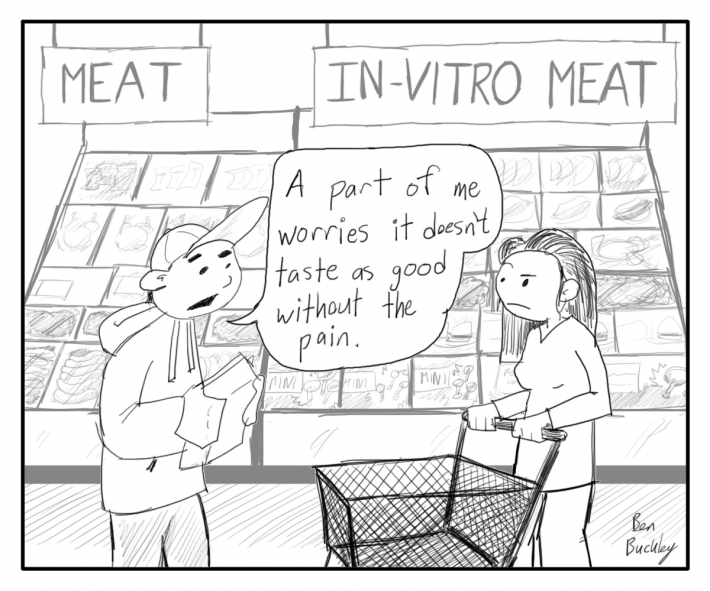
Credit: Ben Buckley
Despite Jimmy's assertion that he 'couldn't see himself eating a ChickieNob', he is seen eating plenty of the stuff later in the time-frame of the novel. The lure of this cheap fast-food is enough to make Jimmy overcome his initial disgust, in a likely parody of our current fast-food culture. The production period is presented as extremely efficient:
"chicken breasts in two weeks -- that's a three-week improvement on the most efficient low-light, high-density chicken farming operation so far devised."
-- Atwood, 'Oryx and Crake', Chapter 8, Wolvogs.
Though research conducted by Maastricht University and others has so far been expensive, Atwood predicts that production of artificial meat will soon become efficient and inexpensive. This is likely to make it the choice of fast-food outlets and people looking for a cheap alternative. Necessity and cost are likely to prevail over people's initial sense of disgust, and possibly any health concerns they may have about the artificial meat. It seems Atwood may have predicted a situation that is likely to occur in the not too distant future. Professor Mark Post, who is team leader of the group from Maastricht University, commented that this way of producing meat has become 'inevitable' because livestock farming is unsustainable. In time, like Jimmy, we may have to face our fear of artificial meat out of necessity.
Atwood also notes that the acceptance of ChickieNobs is likely to be a result of social and cultural pressure. The residents of the Compounds are more technologically advanced and have become comfortable with being surrounded by so much technology, whereas the people from the Pleeblands are more sheltered from this and see the technology as more unnatural and even unethical. This is evident when Jimmy makes the mistake of taking ChickieNobs to dinner with his girlfriend, Amanda Payne, and her artist friends from the Pleeblands. They're more comfortable with cooking their own meals from more natural ingredients and are repulsed by Jimmy's choice, even though it has become very normal for him to eat the artificial meat.
So far it seems that, though expensive, laboratory-grown meat has the potential to be a good substitute for real meat, and it could provide a sustainable way to meet the growing demand for meat, while having a reducer impact on the environment and taking greater concern over animal welfare. However, the public's reaction to this 'unnatural' form of production is likely to be a concern, and as I will explore in Part II, the process of creating this artificial meat has a long way to go before it is commercially viable and 'cruelty-free'.
References & Further Reading
- Atwood, 'Oryx And Crake', Bloomsbury (2003).
- Anhang & Goodland, 'Livestock And Climate Change : What If The Key Factors In Climate Change Are... Cows, Pigs And Chickens?' WorldWatch (2009).
- Cadwalladr, Interview With Professor Mark Post, 'Laboratory-grown beef: meat without the murder, but would you eat it?', The Observer (2014).
- Zhang, 'Artificial Meat Is Gaining Attention in China', Liberty Voice (2014).
- PETA's 'In Vitro' Chicken Contest.
- The In Vitro Meat Consortium.
Listing image: Jason Courtney, 'Pigoons' from Margaret Atwood's 'Oryx And Crake'
